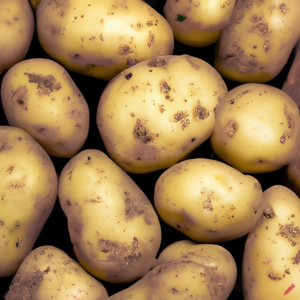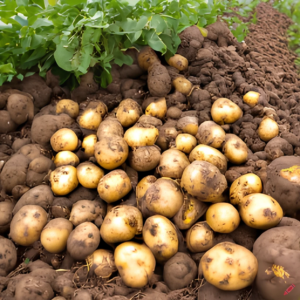
Growing potatoes is a fun and rewarding experience that can yield a plentiful harvest. Here is a step-by-step guide on how to grow potatoes:
- Choose the right variety: Potatoes come in many different varieties, each with its own unique flavor, texture, and growing requirements. Choose a variety that is well-suited to your climate and soil conditions. Some popular varieties include Russet, Yukon Gold, and Red Pontiac.
- Prepare the soil: Potatoes grow best in loose, well-drained soil that is rich in organic matter. Ideally, you should prepare the soil in the fall before planting, but you can also do it in the spring before planting. Loosen the soil to a depth of at least 8 inches and add compost or other organic matter to improve fertility and drainage.
- Planting: Plant seed potatoes in the spring, as soon as the soil is workable. Seed potatoes are small potatoes that are saved from the previous year’s harvest and used for planting. Cut larger seed potatoes into pieces that are about 2 inches in size, making sure each piece has at least one “eye” or sprout. Plant the seed potatoes about 4-6 inches deep and 12-18 inches apart in rows that are 2-3 feet apart.
- Watering: Water the potatoes regularly, aiming to keep the soil evenly moist but not waterlogged. The soil should never dry out completely, as this can stunt growth and reduce yields.

Potatoes - Fertilizing: Potatoes require regular fertilization throughout the growing season. Use a balanced fertilizer with equal amounts of nitrogen, phosphorus, and potassium, and follow the manufacturer’s instructions for application rates and timing.
- Mulching: Mulching helps retain soil moisture and suppress weed growth. Use a thick layer of straw, leaves, or other organic matter around the base of the plants, being careful not to cover the leaves or stem.
- Hilling: As the potato plants grow, they will produce new tubers above the seed potato. To encourage this, hill up the soil around the base of the plants when they are about 6 inches tall. Continue to hill up the soil every 2-3 weeks until the plants are about 12 inches tall. This will encourage the plants to produce more tubers and protect them from sunburn.
- Pests and Diseases: Watch for common potato pests like Colorado potato beetles, aphids, and wireworms, and take appropriate action to control them. Also, watch for diseases like late blight and early blight and take steps to prevent them, such as using a fungicide or removing infected plants.
- Harvesting: Potatoes are ready to harvest when the foliage starts to turn yellow and die back. This usually occurs about 2-3 months after planting, depending on the variety and growing conditions. Carefully dig up the potatoes with a spade or fork, being careful not to damage them. Let them dry in the sun for a few hours, then store them in a cool, dark place.
By following these steps, you can grow delicious, healthy potatoes that will provide a sense of accomplishment and satisfaction. Happy gardening!